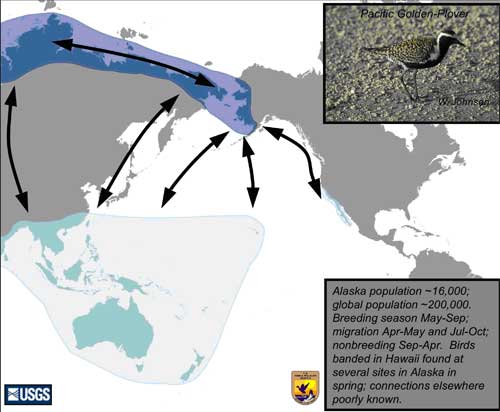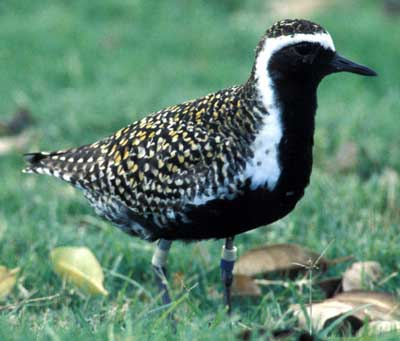Pacific Golden-Plover, Pluvialis fulva
High-Priority Species ListSampling locations: Primary locations will be on the Seward Peninsula (Shishmaref Inlet, and interior locations along the road system), and Oahu, Hawaii. Secondary locations will be along the coast in Bristol Bay (Nushagak Bay, Kvichak Bay, and Egegik Bay) and other islands and other seasons in the Hawaiian Archipelago.
Sampling timeframe: Spring migration (April) at Hawaii. Breeding (May-June) at Seward Peninsula. Post-breeding (late July-late August) at Shishmaref Inlet and coastal sites in Bristol Bay. Nonbreeding (November-December) at sites throughout Hawaii.
Sampling demographics: Adult and juveniles, both sexes.
Methods of capture: Birds will be live captured, swabbed, and released. In Alaska, birds will be captured either with bow traps on nests or mist nets and noose mats set at roosting and foraging sites. In Hawaii, birds will be captured with mist nets on foraging territories or by using spot-lights (to dazzle them) and mist nets at roost sites. Since it will likely be difficult to capture 100s of Pacific Golden-Plovers in Alaska, it will be necessary to collect fecal samples opportunistically from individuals at all sites in all seasons.
Other targeted species: Other priority species available for capture during fall at Pacific Golden-Plover sampling sites include: juvenile Sharp-tailed Sandpipers, adult and juvenile Dunlin (Calidris alpina articola), juvenile Long-billed Dowitchers, and adult and juvenile Bar-tailed Godwits. Pacific Golden-Plovers breed sympatrically with Bar-tailed Godwits on the Seward Peninsula and central YKD, however, both species occur in low densities at these sites and few samples are likely to be obtained during breeding. Ruddy Turnstones could be captured in Hawaii at the same sites as Pacific Golden-Plovers.
Contact: Richard Lanctot
Yukon Delta NWR
Alaska Peninsula-Becharof NWR
Togiak NWR
U.S. Geological Survey
Contact: Robert Gill
Johnson, O. W., and P. G. Connors. 1996. Pacific Golden-Plover (Pluvialis fulva). In The Birds of North America, No. 202 (A. Poole and F. Gill, eds.). The Birds of North America, Inc., Philadelphia, PA.
Johnson, O. W., C. D. Adler, L. A. Ayres, M. A. Bishop, J. E. Doster, P. M. Johnson, R. J. Kienholz and S. E. Savage. 2004. Radio-tagged Pacific Golden-Plovers: Further insight concerning the Hawaii-Alaska migratory link. Wilson Bull. 116: 158-162.
Wetlands International. 2002. Waterbird population estimates-Third Edition. Wetlands International Global Series No. 12, Wageningen, The Netherlands.

Ranking Score: 11.5
Asian H5N1 ranking criteria for Pacific Golden-Plover, Pluvialis fulva.
Total of partial contact with Asia1 |
Contact with known "hot spot"2 |
Habitat used in Asia3 |
Pop. in Alaska4 |
Can samples be obtained? |
Score |
3.0 |
2.0 |
2.5 |
2.0 |
2.0 |
11.5 |
Nesting occurs w. & s.w. Alaska, n. Siberia & Chukotka. Interchange known between Asia & Alaska. Alaska nesting birds disperse to Oceania, Pacific coast of N. & C. America. |
Birds in Oceania likely in contact with birds from c. Asia |
Nests upland tundra; migration and nonbreeding in coastal habitats |
Est. 16,000 |
Could be difficult to obtain target number |

